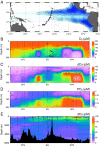Minimal cobalt metabolism in the marine cyanobacterium Prochlorococcus
- PMID: 32576688
- PMCID: PMC7354930
- DOI: 10.1073/pnas.2001393117
Minimal cobalt metabolism in the marine cyanobacterium Prochlorococcus
Abstract
Despite very low concentrations of cobalt in marine waters, cyanobacteria in the genus Prochlorococcus retain the genetic machinery for the synthesis and use of cobalt-bearing cofactors (cobalamins) in their genomes. We explore cobalt metabolism in a Prochlorococcus isolate from the equatorial Pacific Ocean (strain MIT9215) through a series of growth experiments under iron- and cobalt-limiting conditions. Metal uptake rates, quantitative proteomic measurements of cobalamin-dependent enzymes, and theoretical calculations all indicate that Prochlorococcus MIT9215 can sustain growth with less than 50 cobalt atoms per cell, ∼100-fold lower than minimum iron requirements for these cells (∼5,100 atoms per cell). Quantitative descriptions of Prochlorococcus cobalt limitation are used to interpret the cobalt distribution in the equatorial Pacific Ocean, where surface concentrations are among the lowest measured globally but Prochlorococcus biomass is high. A low minimum cobalt quota ensures that other nutrients, notably iron, will be exhausted before cobalt can be fully depleted, helping to explain the persistence of cobalt-dependent metabolism in marine cyanobacteria.
Keywords: Pacific Ocean; Prochlorococcus; iron; nutrient limitation; vitamin B12.
Conflict of interest statement
The authors declare no competing interest.
Figures




References
-
- Moffett J. W., Ho J., Oxidation of cobalt and manganese in seawater via a common microbially catalyzed pathway. Geochim. Cosmochim. Acta 60, 3415–3424 (1996).
-
- Lee B., Fisher N. S., Microbially mediated cobalt oxidation in seawater revealed by radiotracer experiments. Limnol. Oceanogr. 38, 1593–1602 (1993).
-
- Hawco N. J., Ohnemus D. C., Resing J. A., Twining B. S., Saito M. A., A cobalt plume in the oxygen minimum zone of the Eastern Tropical South Pacific. Biogeosciences 13, 5697–5717 (2016).
-
- Ohnemus D. C.et al. ., Elevated trace metal content of prokaryotic plankton communities associated with marine oxygen deficient zones. Limnol. Oceanogr. 62, 3–25 (2017).
-
- Johnson K. S., Coale K. H., Berelson W. M., Michael Gordon R., On the formation of the manganese maximum in the oxygen minimum. Geochim. Cosmochim. Acta 60, 1291–1299 (1996).

